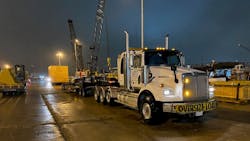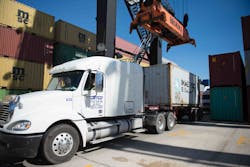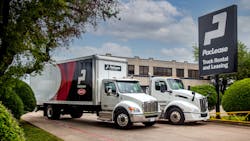Semiconductors have become the national poster child for commercial vehicle equipment shortages. However, there are many other material shortages playing a role as well—anything petroleum- or resin-based, aluminum, copper, and rubber, for example.
When it comes to procuring equipment to move a record amount of freight, the commercial vehicle industry is coming down from pandemic-induced capacity and labor delays in late 2020 and being met with persistent supply chain challenges that ramped up in 2021.
Kyle Treadway, dealer principal for Kenworth Sales, explained that it’s been a moving, shifting situation.
“I can tell you that for the last year, it has felt like whack-a-mole,” Treadway told FleetOwner. “Every time we seem to narrow down and improve a situation, another problem crops up, and that is still the case today."
See also: Intel invests $20B in two new Ohio chip plants
Treadway noted that there are a number of measures Kenworth dealers have taken themselves, as well as in cooperation with suppliers, to keep vehicles up and running. That has meant beefing up inventories and ramping up communication with fleet customers and suppliers to let them know the status of replacement parts and components.
“We had all worked ourselves into a just-in-time mode a couple of years ago, and that has just positioned us to be vulnerable,” Treadway said. “We’re improving the stocking quantities that we have by using dealer management software to help us try and manage the different seasonality and cycles so we can accommodate longer lead times in ordering supplies.”
In October 2021, everything turned on a dime, Treadway pointed out.
“Our entire order board was canceled, and we had to go to our customers and say, ‘Force majeure—that contract that we had with you is no longer any good; we have to resubmit. You may not get the model you want, the spec you want, the engine you want. You may not get it when you want it, and you certainly aren’t going to get it for the price we previously agreed to,’” he said.
For Treadway, that’s when relationships with the OEM, supplier, and fleets became more important than ever.
“You have to have built a history with all of those stakeholders so that they understand the message you’re delivering and the context in which it’s made,” Treadway advised. “You also have to keep in mind that you want to do business with your customer five years from now, so you want to do whatever it takes to maintain that relationship.”
Jetco Delivery, which provides intermodal, open deck, heavy haul, dry van, asset-backed freight brokerage, and warehousing services, hasn’t necessarily had trouble procuring equipment; the difficulty has been long lead times. Companywide, Jetco and its parent company, GTI Group, run about 140 trucks—mostly Freightliners in the Houston market and Peterbilts in Canada.“If you need new equipment, you have to plan that much further ahead,” explained Brian Fielkow, Jetco's CEO. “Because of the lag times with new equipment, it has put pressure on the used-equipment market. A truck that you might have paid a certain amount for could cost you 50% more."
“The difficulty is that you don’t get the equipment as fast as you want, but our experience with the dealers so far has been what they’ve promised, they’ve delivered,” he added. “It just hasn’t been the news that we wanted.”
For example, Jetco ordered its first wave of natural gas trucks back in July, and Fielkow doesn’t anticipate the trucks will arrive until April, “if we are lucky.”
Even with today’s equipment backlog challenges, Fielkow isn’t comfortable jumping into the used-truck market if he doesn’t have to. ACT Research recently reported average used-truck prices are up more than 83% compared to January 2021, with average month-over-month prices 7% higher compared to December 2021.
Trucking companies are paying such high premiums on older trucks that are likely going to require higher maintenance. These companies might risk owing a lot more than the truck is worth, Fielkow noted.
“You have to have a point of view on where the market is going,” he said. “By no means am I pessimistic, but I am not going to delude myself into thinking that this is a new normal, either. I don’t think we are in a new normal. We’re not staffing up our truck count to meet some sort of hypothetical new normal.”
A focus on PMs
To navigate the current climate, Jetco has been “extremely rigorous” on when trucks are put down for preventive maintenance (PM) intervals, Fielkow explained. And if the fleet finds issues on driver vehicle inspection reports, technicians address them immediately.
“We don’t let maintenance build up; it’s a best practice for keeping your fleet running,” Fielkow said. “It’s also a best practice for safety. We have been running our playbook there. We are hanging onto trucks a little bit longer than we wanted to as a function of the market, but we are not having any problem running them. The older the truck is, the more it will cost you per mile to maintain, so you have to budget that in.”Keeping up with those PMs is also critical for safety, particularly when carriers are busy hauling high demands of freight, and the supply chain is this stretched.
“That translates to tremendous production pressure,” Fielkow said. “Production pressure is good. It means we are busy, but if you let that fool you into cutting corners or saying I know this truck is due for a PM but let me get another 5,000 miles out of it, that’s when bad things start to happen."
“If you lose sight of your foundation, which is safety, which is PMs, which is making sure people aren’t running so hard that they are fatigued, it’s all for naught,” he added.
Getting creative
As a lessor, PacLease has been evaluating all equipment it has in service—even assets that were due to mature in 2021 or early 2022. Amid persistent supply challenges, PacLease took a thorough look at where it could extend that equipment so fleets could hold onto it longer.
See also: The world is changing fast, and trucking industry must, too, says DTNA CEO
“We’ve really had to look at the date expenses and do a thorough review to determine which ones were trending the wrong way as far as maintenance costs and downtime,” Todd Berger, director of sales for PacLease, told FleetOwner. “We retired that equipment and replaced it with rental equipment where available.”
Berger, who has been in the industry since 1982, said he’s never seen anything that has had such an impact on the supply chain piece and commercial truck builds.
“We’ve had downtime, and we’ve had recessions where the need wasn’t there, but to have a need at record levels and to not be able to build trucks is pretty frustrating,” he stressed.PacLease has had to work closely with its fleet customers to help them satisfy their need so they could deliver for their end customers. Most of PacLease’s customers serve the traditional food service, building materials, petrochemical, furniture, and general freight markets, Berger pointed out.
The average lease account in a market might run up to five trucks, while major food service or petrochemical operations might operate 20-plus power units.
“While it’s not many trucks, those trucks are their lifeblood,” Berger emphasized. “Sometimes we have to get creative because the equipment that we lease to customers aren’t just standard stock trucks that are just bought off the dealer lot. They’ve got PTOs, pumps, liftgates, refrigeration units, etc. We have to ensure that we are providing specialized equipment to them on lease and that we equip our rental fleets in a similar fashion.”
Berger further explained that most PacLease franchises build their rental fleets around their lease fleets for replacement needs and to substitute vehicles when trucks are down. Lately, in some cases, PacLease had to redeploy and reposition equipment from market to market based on need.
“We did everything in our power to work with each and every one of our customers to meet the commitments that we made when we placed the order for the fleet,” Berger said. “In some cases, we converted that order because we couldn’t get the rental equipment. Instead of doing a five- or six-year deal on a new asset, we did a three-year deal on a ‘light new’ asset—maybe a two- or three-year-old truck from our rental fleet.”
For the most part, PacLease franchises are Kenworth and Peterbilt truck dealers that also have retail stock. Franchises have also had to get creative when utilizing stock that was not planned for the leasing fleet but from retail stock to accommodate fleets’ needs.
“We’ve been in much worse situations than this; 1980 was horrific and we survived it,” Kenworth Sales' Treadway said. “I think we need to try to help everyone avoid the panic button.”







